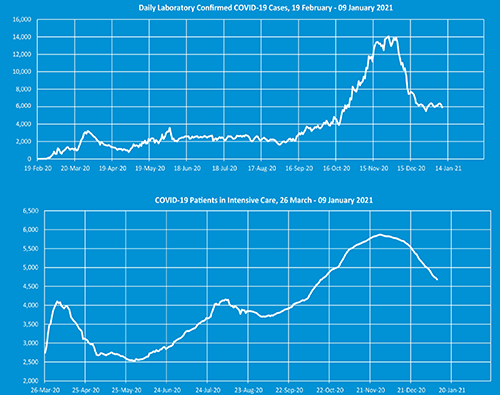Tehran, 11 January 2021 - The World Health Organization (WHO) and the Ministry of Health and Medical Education of the Islamic Republic of Iran have delivered life-saving medical and diagnostic equipment to public hospitals and laboratories across the country to support the fight against the COVID-19 pandemic.
The procurement is part of the COVID-19 Emergency Response Project (ICERP), a collaboration between WHO and and the Ministry of Health and Medical Education initiated on 16 June 2020 and funded at US $50 million in an effort to support the country’s health care system in diagnosing and treating patients with COVID-19.
“We are facing even more risks in winter and urgently need more resources and more projects like ICERP to support the Ministry to scale up hospital and laboratory capacities serving all people in Islamic Republic of Iran, in parallel with all preventive measures and work towards a vaccine,” said Dr Christoph Hamelmann, WHO Representative in Islamic Republic of Iran.
By its closing date on 31 May 2021, the project is planned to procure and deliver a total of 316 medical devices, including CT scanners, ultrasound machines, portable digital x-ray machines, as well as 135 diagnostic laboratory devices and their consumables. The devices are being distributed to 136 public hospitals and 43 laboratories across the country caring for COVID-19 patients.
The Ministry confirmed the country's first 2 cases of COVID-19 on February 19 in the city of Qom situated near the capital Tehran. Since then, 1 280 438 laboratory confirmed COVID-19 cases were reported and 54 100 COVID-19 related deaths as of 9 January 2021.
 Number of laboratory-confirmed COVID-19 cases (top) and ICU hospitalisations (bottom) in I.R. Iran since the beginning of the epidemic in February 2020 @WHO/Islamic Republic of Iran
Number of laboratory-confirmed COVID-19 cases (top) and ICU hospitalisations (bottom) in I.R. Iran since the beginning of the epidemic in February 2020 @WHO/Islamic Republic of Iran
At the recent highest peak on 27 November, a total of 5860 patients were hospitalized in intensive care units, posing serious challenges for all hospitals and health care workers throughout the country.
To guide the response, WHO monitors the COVID-19 situation on a daily basis and prepares a comprehensive report which includes daily and cumulative figures, risk status for Islamic Republic of Iran’s provincial capitals, updates on the imposed national and international travel restrictions, and useful links. The report archive can be accessed here.
Re-imposed unilateral sanctions had already put pressure on the country’s economy and health care system before the COVID-19 epidemic started in early 2020. “The sanctions add a further level of challenge in an already strained market for COVID-19 emergency goods,” said Dr Hamelmann. “In addition, under sanctions the fiscal space is much smaller to sustain the economy and livelihoods, particularly of the poor, during times when public health measures restrict so severely social and economic life, affecting lengths and depths of these measures.”
Prior to the arrival and installation of the equipment, a detailed on-site environmental and occupational health, patient safety and social standard assessment is conducted in all selected facilities by WHO’s in-house and recruited external local experts. Improvements are implemented as needed by the Ministry in order to ensure that the new equipment will save lives.
There are 10 key steps to go through before the equipment enters the country and reaches its destination, including bidding, purchase order, shipment, customs clearance, site readiness, central warehousing, distribution, handover, installation, and training medical staff. The entire procurement and logistical process is shown in the picture below.
 The meticulous and colour-coded infographic of the principle steps for procurement and logistics under ICERP was developed based on the distribution strategy. Every procedure under ICERP follows this order and color codes. @WHO/Islamic Republic of Iran
The meticulous and colour-coded infographic of the principle steps for procurement and logistics under ICERP was developed based on the distribution strategy. Every procedure under ICERP follows this order and color codes. @WHO/Islamic Republic of Iran
In this collaborative effort, WHO is standing by the national health system, medical teams, and people of Islamic Republic of Iran to get through this emergency together, by increasing access to life-saving services, early diagnosis, and contact tracing, thereby, contributing to keeping the country on the path towards universal health coverage.
We welcome your feedback through the hotline 190 on extension 7 dedicated to ICERP, or via the email










